
Purpose The purpose of this study was to provide useful information on the improvement of performance by measured the psychological-physiological stresses experienced by elite shooters during a competition. Methods Thirty-eight elite shooters participated in this study (Male = 13, Female = 25). Psychological stress was measured and used for this study based on the stress factors found in the elite target stress study by Park(2015). The cortisol, a physiological stress hormone, was measured using saliva. Results The reliability of the psychological stress sub-factor pre-post analysis results showed no statistically significant. The concentration of cortisol measured on the day before the competition (0.1704 µg/dL) significantly increased immediately before the competition (0.3558 µg/dL). Cortisol immediately before the competition showed negative correlation (r=-.361, p=.036) with the competition score, and the regression variable of cortisol was 13%. Conclusions In this study, physiological stress had a negative effect on elite shooters performance compared to psychological stress.

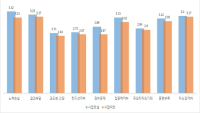


Purpose The purpose of this study was to investigate the effect of vibration therapy on the functional, imaging, and mechanical properties in elbow flexor after a single bout eccentric exercise. Methods Twenty-three untrained adults male participated in this study [CON(control)= 11, VT(vibration)= 12]. Volunteers performed 5-set of 6 maximal (90˚/s) eccentric contractions of the non-dominant elbow flexor on a isokinetic dynamometer. Vibration was applied using a side alternating vibratory platform (12 Hz frequency, 4 mm amplitude) with 3-set of 60 sec during 3-day after eccentric exercise. Results The VT group showed a reduction in exercised-induced muscle damage(EIMD) symptoms in the form of attenuating muscle swelling and echo intensity (P<.05) compared with the CON, mechanical properties were improvement (P<.05) compared with the CON. However, muscle soreness, range of motion and maximal voluntary isometric contraction were not significant (P<.05). Conclusion As currently practiced, vibration therapy after eccentric exercise may reduce EIMD by improving quality of the muscle, suggesting that this therapy is an effective strategy for EIMD.


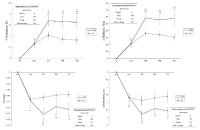
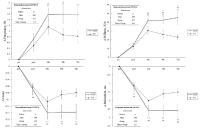
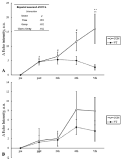
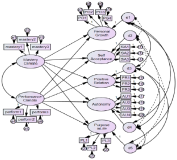
Purpose This study identified the influence of perceived motivational climate on psychological well-being in ballet majors. Methods Participants were 211(male=25, female=186) collegiate students enrolled in ballet department. Measures were The Perceived Motivational Climate in Sport Questionnaire(PMCSQ) and Psychological Well-being Questionnaire. Data were analyzed by using descriptive statistics, reliability test, correlation, and structural equation modeling. Results Results were as follows. First, mastery climate who ballet majors perceive significantly influenced on the five subscales of their psychological well-being: Mastery climate was positively related to personal growth, self-acceptance, positive relation with others, autonomy, and purpose in life. Second, performance climate who ballet majors perceive significantly influenced on the five subscales of their psychological well-being: Performance climate was negatively related to personal growth, self-acceptance, positive relation with others, autonomy, and purpose in life. Model fit indices were acceptable(RMSEA=.070). Conclusion In conclusion, this study indicated that motivational climate who ballet majors perceive was a important situational factor on their psychological well-being.

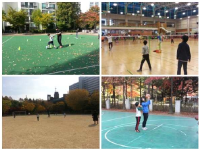
Purpose The purposes of this study were to examine the influence of a formal sports mentoring program on mentors(pre-service PE teachers), and to identify main factors affecting educational growth of the pre-service teachers. Methods Data were generated in this study using: In-depth interviews, mentoring observations, and document resources from 4 mentors and their mentees as research participants. The collected data were inductively analyzed as an iterative process of working back and forth between the data and the categories(Miles & Huberman, 1994). Results The key findings of this study are as follows. First, mentors developed pre-service teachers’ practical knowledge including teaching knowledge, environment knowledge, student knowledge within teaching contexts. Furthermore, they practiced mentee-centered education through sports mentoring not only by mentees but also for mentees. Second, with respect to the factors impacting mentors’ educational growth, there were two main factors; the systematic structure of a program and mentors’ reflexivity. Mentors improved practical knowledge through the circular ‘experiential learning’ phases the sports mentoring program provided. In addition, mentor had valuable opportunities to learn how to care mentees by reflecting on positive and negative influences deriving from interactions with their mentees. Conclusion Potential benefits were embedded in inherent nature of sport and the unique structure of mentoring. sports mentoring can provide experience of learner-friendly teaching distinct from classes of lecture type. It is necessary to be reconsidered as pre-service PE teacher education program with opportunities of other teaching practice.




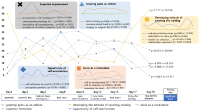
Purpose The current study aimed to identify national youth cyclist`s experience and change tendency of experience during camp training. Methods A total of 35 cyclists who participated in 2017 Korea youth national cycling camp training provided the data. The survey was conducted 9 times during the 20 days of camp training using open-ended questionnaire by diary method. The collected data were analyzed based on inductive categorization and response rates. This study was conducted in the order of formation rapport, data collection, and data analysis. Results Youth cyclists experiences during camp training to growing pains as an athlete, developing the attitude of savoring training, serve as a motivation, expertise formation and opportunity of self-examination. Based on the change in response frequency of the survey data, camp training experience falls into two categories: variable and invariable. Conclusions Youth national cyclist were growing their growth power through various experiences during the training camp, and these experiences changed to specific inflection points from the beginning to the end of the camp. Understanding changes in psychological experience can provide the design of timely psychological support and coaching method. This study will be used as a material for the design of the camp training program for the youth cyclist, as well as an opportunity to increase the interest of continuity reflection on the psychological experience.

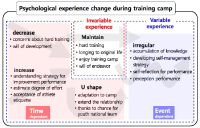

Purpose In general, motor imagery and action observation have been distinguished from each other. Recently, several studies demonstrated that combined approach to motor imagery and action observation can be more effective in motor learning. The present study examined the effects of observation learning combined motor imagery and action observation during acquisition basketball shooting skills. Methods We divided with control group, action observation group and observation learning group combined mental image and action observation in the three middle school. Action observation group provided the action observation program, and observation learning group was performed observation learning combined mental image and action observation training. All groups were perform basic basketball skills. Experimental intervention was performed for 10 weeks, and data analysis was performed 3 groups × 2 time repeated ANOVA. Results The results indicated that all group were improve after intervention, and subjects who participated in combined mental image and action observation was significant in the interaction effect on the front shoot. Moreover, the interaction effect on the motor imagery ability was significant. Conclusions These findings suggest that the use of observation learning combined mental image and action observation strategy potentially optimizes motor skills performance and motor image ability by incorporating motor imagery, especially when observing movements with intent to imitate.

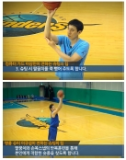

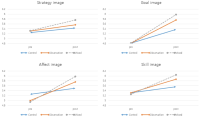
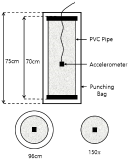
Purpose The purpose of this study is to investigate the comparison of peak resultant force in taekwondo body dollyeochagi in accordance with Jejariditgi existence and the position of kicking leg. Methods Twelve students who majored taekwondo participated in this experiment. They have a forth dan(degree) black belt in taekwondo. The peak resultant force was measured 12 times(2 jejariditgi existence × 2 position of kicking leg × 3 times). Two-way ANOVA with repeated measures was used to analyze the data. Results There was significant difference in interaction effect of peak resultant force in taekwondo in accordance with jejariditgi existence and the position of kicking leg. And there was significant difference in main effect of peak resultant force in taekwondo in accordance with jejariditgi existence and the position kicking leg. Higher peak resultant force was shown in body dollyeochagi with jeariditgi as compared with non jejariditgi. And higher peak resultant force was shown in rear kicking leg as compared with front kicking leg. Conclusions The results show that jejariditgi is a factor affecting the peak resultant force. Comparison of peak resultant force in taekwondo body dollyeochagi in accordance with jejariditgi existence and the position of kicking leg will provide strategies for coaches and athletes to perform improved taekwondo dollyeochagi.



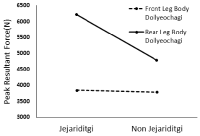

Purpose The purpose of this study is to compare the physical fitness levels among artistic swimmers in artistic swimmer national team trials. It is aimed to strengthen the physical fitness evaluation criteria of the national team and construct a physical fitness evaluation item suitable for an artistic swimming event. Methods A total of twenty two female elite artistic swimmers participated in this national team selection trial. Measurement list was performed body composition (Height, Weight, Body fat(%), Skeletal muscle mass, Lean body mass, BMI, Shoulder width, Arm span), Basic physical fitness (Push-up, Sit-up, Chin-up, Endurance of trunk backward extension and Sargent jump), Flexibility (Trunk backward extension, Shoulder flexibility, Frog position and Underwater split R, L) and Swimming test (100 m freestyle, 400 m freestyle). Data were analyzed by Independent t-test using SPSS Statistics ver 25.0. Results Age and skeletal muscle mass were significant difference between the two groups (p<.05). Also, 400 m swimming test was significantly different (p<.001). However, there were no significant differences in basic physical fitness and flexibility. Conclusions These results suggest that selected athletes are excellent not only in acting but also in physical fitness. Based on these results, it is necessary to construct a physical fitness items for the preliminary artistic swimming and to classify the physical fitness evaluation criteria according to the characteristics of the artistic swimmers.


Purpose The purpose of this study was to identify the effect of a power-specific weight training program in order to improve the muscle strength of Korean national team’s freestyle wrestlers. Methods Participants were 13 male athletes in the national freestyle wrestling team. The period of the program was 6 weeks. Muscle strength, muscular endurance, muscle power, flexibility, agility, cardiorespiratory endurance, anaerobic power and isokinetic muscle function were measured. Data were analyzed using IBM SPSS Statistics ver. 23.0 (IBM Co., Armonk, NY, USA). Paired t-test was conducted for comparison between pre-test and post-test score. Results There were significant difference and tendency in the leg isokinetic power and trunk isokinetic flexion strength. However, there was no significant difference in muscle strength, muscular endurance, muscle power, flexibility, agility and cardiorespiratory endurance. Conclusion The 6-week program focusing on the power-specific weight training indicated a significant difference not in every variable but in isokinetic muscle power, speed power and core strength. It is suggested that the training program was applied to the athletes less continuously and not in the long term because of frequent international games abroad and the need for losing weight. Consequently, a year-long training program with personalized methods should be developed to bring about more significant outcomes.
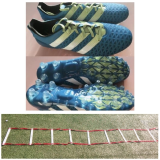
Purpose The purpose of this study was to investigate the lower extremity muscles activity during forward side step by soccer field ground types. Methods Fifteen elite high school soccer players participated in this study. Muscle activation patterns were recorded at 2000 Hz during forward side step task. Surface EMG of the tibialis anterior(TA), soleus(SOL), medial gastrocnemius(MG), lateral gastrocnemius(LG), peroneus brevis(PB) muscle was recorded, and the root mean square of the EMG was normalized, using a maximum voluntary isometric contraction(%MVIC). One-way repeated ANOVA was used for comparison among three soccer field ground types(natural grass, artificial turf, hard ground). Results Artificial turf displayed greater soleus and peroneus brevis activities compare to natural grass during forward side step task. Conclusions The relationship between increased soleus and peroneus brevis activation and greater incidence of injury in artificial turf versus natural grass requires further study. Soccer players routinely training on artificial turf for prolonged periods should be carefully monitored.

